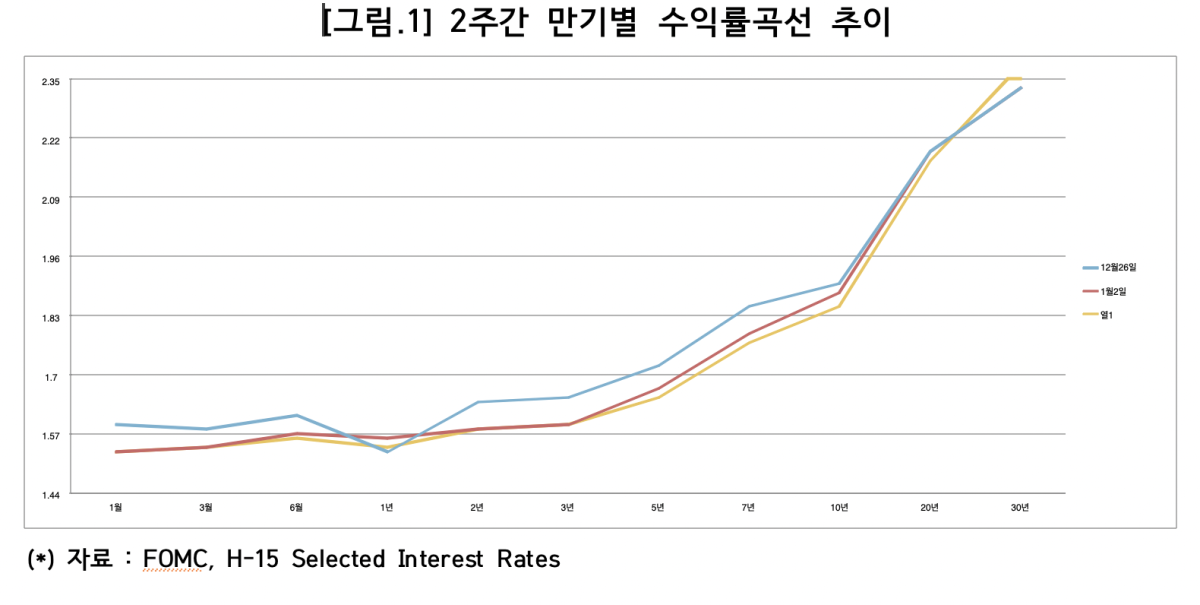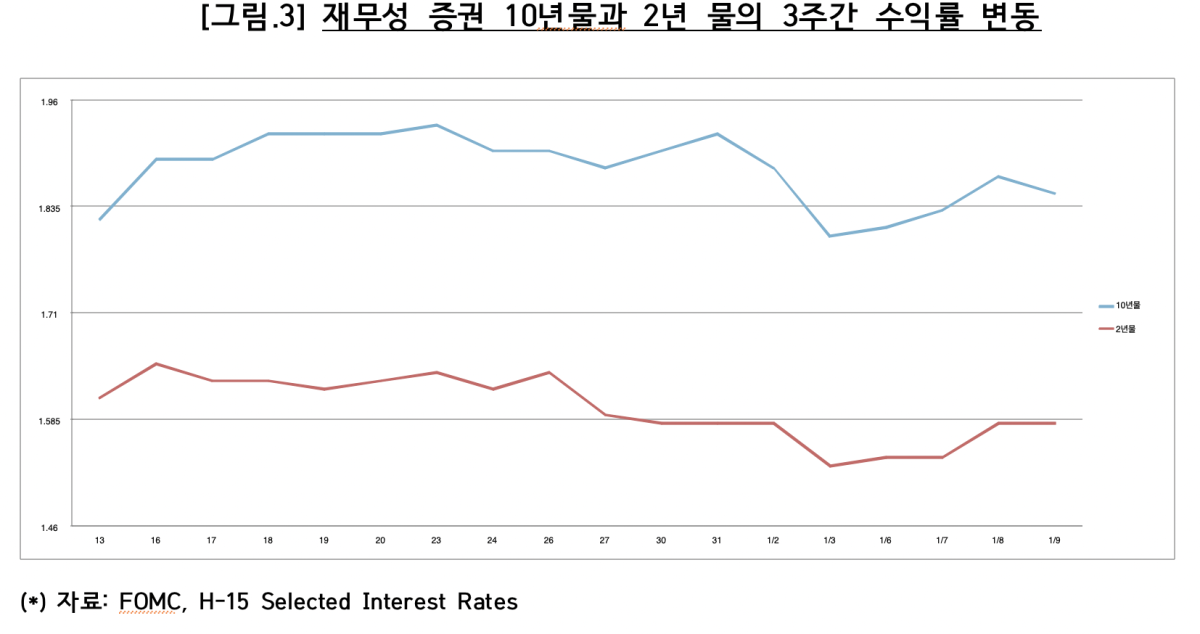국가미래연구원은 폭 넓은 주제를 깊은 통찰력으로 다룹니다
※ 여기에 실린 글은 필자 개인의 의견이며 국가미래연구원(IFS)의 공식입장과는 차이가 있을 수 있습니다.
[Fed Watch] 30년물 외 대부분 불변 혹은 소폭 하락 - 2020.1.14 본문듣기
작성시간
- 기사입력 2020년01월13일 17시00분
- 최종수정 2020년01월13일 16시22분
관련링크
본문
<1> 금주 T-Bill 수익률과 Yield Curve :
■ 금주에도 지난주와 마찬가지로 1bp-3bp 내외의 전반적인 소폭 하락세 시현
- 1월, 3월, 2년 3년 물 수익률은 불변,
- 30년 물 수익률은 5bp 상승, 그 외 모두 1bp-3bp 수익률 하락
■ 2년물과 10년물 수익률이 다시 상승세로 돌아섬.
- 10년물과 2년물 격차가 27bp로 다소 감소
<2> Tim Duy(오레곤 대학교 교수)의 Fed Watch(JANUARY 8, 2020)
“시장은 또 하나의 탄탄한 고용통계를 기대하고 있다.“
(Markets Looking For Another Solid Employment Report)
■ Keeping the Fed on the sidelines means having enough positive data to keep their forecast near one consistent with trend growth but not enough positive data to make them think they need to reverse last year’s rate cuts.
It’s hard to see the latter situation happening anytime soon with Federal Reserve Chairman Powell looking for either actual, significant inflation or a real risk of significant inflation before raising rates.
Instead, incoming data looks to be closer to trend growth; the employment report is expected to conform with that outlook.
■ Last week, the ISM manufacturing index disappointed, stubbornly refusing to match the more optimistic PMI story. Manufacturing, however, is only a part – an increasingly smaller part – of the economy.
A manufacturing recession no longer guarantees an economy-wide downturn, a lesson learned in 2015-16. As far as recessions are concerned, we should be on the lookout for economy-wide shocks that pull down the services sector along with manufacturing.
So far though the services sector remains resislient as seen in this week’s ISM services report:
This kind of divergence is what we saw in 2015-2016; note the contrast with 2007-2009 when both measures move in virtual lockstep deep below 50. That’s what we would expect with an economy wide shock and aren’t seeing now.
I have been on this soapbox before, but I will get on it again:
If the manufacturing cycle is less tied with the overall cycle than it has been in the past, a lot of analysis is going to be upended.
We need to be very careful when telling economy-wide stories with the manufacturing data.
■ As far as the Fed is concerned, the softness in manufacturing and associate economic risks were enough to justify last year’s rate cuts. The resiliency of the rest of the economy prevents any further cuts. Friday’s employment report is expected to confirm that resiliency. Wall Street expects a Goldilocks report with nonfarm payrolls growing by 164k, unemployment holding steady at 3.5%, and wages up 3.1% over the past year. Those are numbers that the Fed will see as consistent with solid but not spectacular trend-like growth with no reason to believe the economy is overheating or will soon overheat.
Today’s ADP number surprised on the upside with a 202k gain in private employment and thus provides for the possibility of an upside surprise Friday. My payrolls estimate for the report is a tad higher than Wall Street at 188k:(실제 : 14만 5천, 실업률 3.5%, 임금 2.9% 증가)
Anything in that zone would be consistent with the Fed’s basic story. Whatabout outside that zone? Realistically, the data is sufficiently noisy that no single data point would change the overall story. We should instead be looking for patterns of data that threaten to send unemployment higher to justify a rate cut. So a single weak report would likely not do that in any meaningful way; two or three consecutive weak reports would be more interesting.
- 기사입력 2020년01월13일 17시00분
- 최종수정 2020년01월13일 16시22분
댓글목록
등록된 댓글이 없습니다.



